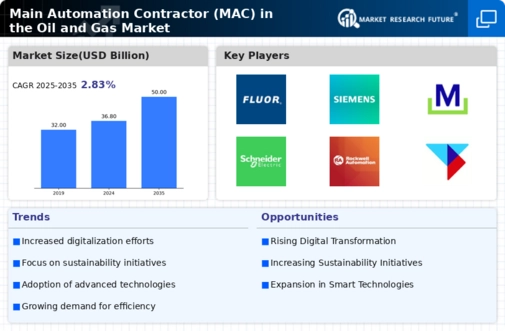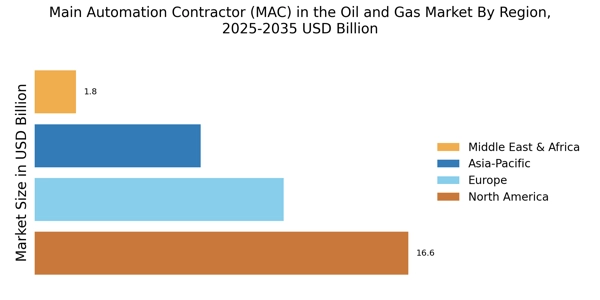Focus on Sustainability
A growing emphasis on sustainability is reshaping the Main Automation Contractor (MAC) in the Oil and Gas Market. Companies are under pressure to reduce their carbon footprint and enhance environmental stewardship. This shift is prompting MACs to develop automation solutions that facilitate cleaner operations, such as emissions monitoring and energy management systems. According to recent data, investments in sustainable technologies are projected to reach $1 trillion by 2030, indicating a robust market for MACs that prioritize eco-friendly practices. By aligning their strategies with sustainability goals, MACs can not only comply with regulatory requirements but also attract environmentally conscious clients, thereby expanding their market share.
Collaborative Partnerships
Collaborative partnerships are increasingly becoming a cornerstone of the Main Automation Contractor (MAC) in the Oil and Gas Market. As projects grow in complexity, the need for specialized expertise has led to alliances between MACs and technology providers, engineering firms, and even academic institutions. These collaborations enable the sharing of knowledge and resources, which can lead to innovative solutions that enhance project delivery. For example, joint ventures can facilitate the development of cutting-edge automation systems that improve operational efficiency. The trend towards collaboration is expected to continue, as companies recognize that leveraging diverse skill sets can lead to more successful project outcomes.
Integration of Advanced Technologies
The integration of advanced technologies is a pivotal driver in the Main Automation Contractor (MAC) in the Oil and Gas Market. The adoption of digital solutions, such as artificial intelligence and machine learning, enhances operational efficiency and decision-making processes. For instance, the implementation of predictive maintenance systems can reduce downtime by up to 30%, thereby optimizing production. Furthermore, the use of Internet of Things (IoT) devices allows for real-time monitoring of equipment, which is crucial for maintaining safety and compliance standards. As the industry increasingly embraces automation, MACs are positioned to lead the way in deploying these technologies, ensuring that oil and gas operations are not only efficient but also resilient against market fluctuations.
Market Demand for Operational Efficiency
The relentless market demand for operational efficiency is a significant driver in the Main Automation Contractor (MAC) in the Oil and Gas Market. Companies are continually seeking ways to reduce costs and improve productivity, which has led to an increased reliance on automation technologies. Data indicates that automation can lead to cost savings of up to 25% in operational expenditures. MACs are at the forefront of this trend, providing solutions that optimize processes, enhance data analytics, and improve overall performance. As the industry evolves, the ability to deliver efficient and cost-effective automation solutions will be a key differentiator for MACs, influencing their competitive positioning in the market.
Regulatory Compliance and Safety Standards
Regulatory compliance and safety standards are critical drivers in the Main Automation Contractor (MAC) in the Oil and Gas Market. The oil and gas sector is subject to stringent regulations aimed at ensuring safety and environmental protection. MACs play a vital role in helping companies navigate these complex regulatory landscapes by providing automation solutions that enhance compliance. For instance, automation systems can streamline reporting processes and ensure that safety protocols are consistently followed. As regulatory scrutiny intensifies, the demand for MACs that can deliver reliable compliance solutions is likely to increase, positioning them as essential partners in the industry.


















Leave a Comment